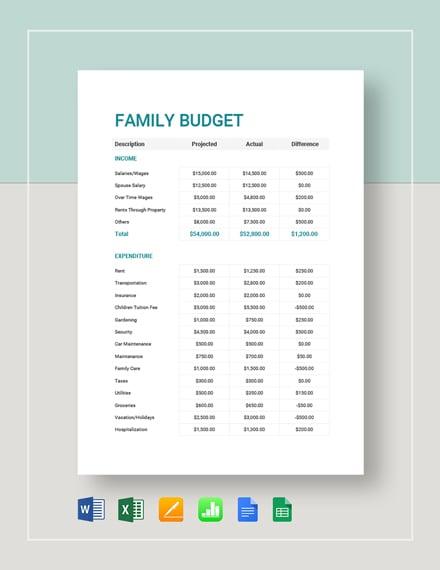In an era marked by economic uncertainty and fluctuating financial landscapes, the importance of a well-structured family budget cannot be overstated. Yet, crafting a budget that not only addresses the diverse needs of each family member but also garners collective adherence often presents a formidable challenge. This article delves into the analytical frameworks and strategic approaches essential for developing a family budget that is both comprehensive and sustainable. By examining the psychological and financial dynamics at play, we aim to equip families with the tools necessary to foster financial harmony and resilience. With confidence in evidence-based strategies and a commitment to practical application, we explore how to transform budgeting from a source of tension into a collaborative effort that empowers every family member to contribute to and benefit from a shared financial vision.
Identifying Essential Expenses and Prioritizing Family Needs
In the journey of crafting a family budget that works for everyone, distinguishing between essential and non-essential expenses is pivotal. Essential expenses are those that ensure the well-being and basic functioning of your household. These often include:
- Housing costs such as rent or mortgage payments
- Utilities like electricity, water, and internet
- Groceries and other necessary food items
- Healthcare including insurance and medications
- Transportation costs to get to work or school
Once these are identified, prioritize them by understanding which needs are most critical to your family’s daily life. This ensures that you allocate resources effectively and avoid unnecessary financial stress. Analyzing past spending patterns can help reveal areas where adjustments can be made, freeing up funds for other priorities or savings. Balancing these essentials with a focus on your family’s unique needs fosters a budget that is both sustainable and supportive of your collective goals.

Implementing Practical Saving Strategies for Long-Term Stability
Crafting a family budget that stands the test of time involves a blend of strategic planning and inclusive communication. Start by assessing your financial landscape, considering both fixed and variable expenses. This understanding provides a solid foundation for decision-making. Engage every family member in the process, ensuring that all voices are heard and priorities are aligned. This collaborative approach not only fosters accountability but also encourages a sense of shared responsibility. By doing so, you lay the groundwork for a budget that is both realistic and resilient.
Consider implementing these practical strategies to enhance financial stability:
- Prioritize Savings: Allocate a specific percentage of your income to savings before addressing other expenses. Treat savings as a non-negotiable expense.
- Track Spending: Use digital tools or apps to monitor your spending habits. This data-driven insight helps in identifying areas for cost-cutting.
- Set Short and Long-term Goals: Define clear objectives for both immediate needs and future aspirations, such as vacations, education, or retirement.
- Review and Adjust: Regularly revisit your budget to accommodate changes in income or unexpected expenses, ensuring it remains flexible and effective.
By adopting these strategies, families can navigate financial challenges with confidence, creating a sustainable budget that supports long-term stability.

Fostering Family Involvement and Accountability in Budgeting
One of the most effective ways to ensure family involvement and accountability in budgeting is to make the process inclusive and transparent. Start by organizing a family meeting where everyone can contribute to setting financial goals. This approach not only democratizes the process but also ensures that every family member understands the importance of budgeting. During this meeting, encourage open dialogue about spending habits and financial priorities. Transparency is key; therefore, consider sharing a breakdown of income and expenses to make sure everyone is on the same page.
- Assign Roles: Designate specific responsibilities, such as tracking expenses or researching cost-saving opportunities, to different family members.
- Set Up Regular Check-Ins: Schedule monthly or bi-weekly meetings to review the budget and make adjustments as necessary.
- Celebrate Milestones: Acknowledge when financial goals are met to reinforce positive behaviors and keep motivation high.
By fostering a collaborative environment, you create a sense of ownership and accountability among all family members, making it easier to stick to the budget and achieve collective financial success.

Utilizing Technology to Track Spending and Adjust Financial Goals
In the digital age, leveraging technology to monitor and adjust your financial habits can be a game-changer for maintaining a family budget. Utilizing apps and online tools, families can gain real-time insights into their spending patterns and make informed decisions about their financial goals. Budgeting apps such as Mint, YNAB, or PocketGuard provide an intuitive interface to track expenditures, categorize expenses, and set spending limits. These platforms often offer features like alerts for overspending and monthly reports that highlight areas for potential savings.
- Real-time Tracking: Instantly see where your money is going, allowing for timely adjustments.
- Goal Setting: Set and adjust savings goals directly within the app, making it easier to stay motivated.
- Automated Insights: Receive personalized recommendations to optimize your budget based on your spending habits.
By incorporating these digital tools, families can not only track their spending more efficiently but also make data-driven decisions to adjust their financial goals as needed. This proactive approach fosters a collaborative family environment where everyone is on the same page, leading to more successful budgeting outcomes.



